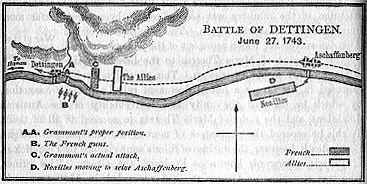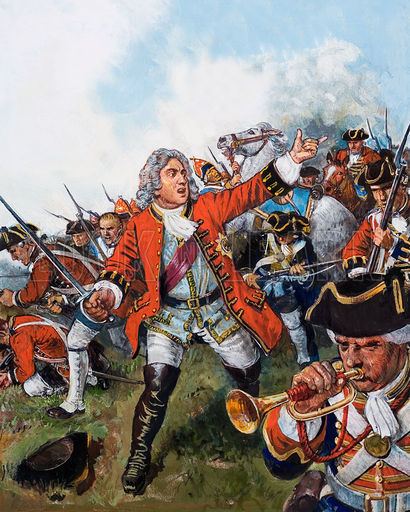Date 27 June 1743 | Result Allied victory | |
35,000–37,00015 British battalions18 British squadrons14 Austrian battalions10 Austrian Squadrons13 Hanoverian battalions16 Hanoverian squadrons98 guns 23,000 engaged of 45,0005 Infantry Brigades27 Squadrons56 guns 2,000 – 3,000British 337 Horse, 494 FootHanoverians 20 Horse, 533 FootAustrians 65 Horse, 912 Foot 4,000-4,500526 Horse3680 Foot33 Artillerymen Combatants Austria, Kingdom of Great Britain, Habsburg Monarchy, Electorate of Brunswick‑Lüneburg, Early modern France Similar War of the Austrian Succession, Battle of Fontenoy, Battle of Lauffeld, Battle of Rocoux, Battle of Chotusitz | ||
The battle of dettingen the story of a cunning plan
The Battle of Dettingen (German: Schlacht bei Dettingen) took place on 27 June 1743 at Dettingen on the River Main, Germany, during the War of the Austrian Succession. The British forces, in alliance with those of Hanover and Hesse, defeated a French army under the duc de Noailles. George II commanded his troops in the battle, and this marked the last time a British monarch personally led his troops on the field. The battle straddled the river about 18 miles east of Frankfurt, with guns on the Hessian bank but most of the combat on the flat Bavarian bank. The village of Dettingen is today the town of Karlstein am Main, in the extreme northwest of Bavaria.
Contents
- The battle of dettingen the story of a cunning plan
- Battle of dettingen
- Prelude
- Battle
- Notable incidents
- Legacy
- References
Battle of dettingen
Prelude

The allied army was known as the Pragmatic Army because it was a confederation of states that supported the Pragmatic Sanction of 1713 agreements to recognize Maria Theresa as sovereign of the Habsburg Empire. The British force of 17,000 men under John Dalrymple, 2nd Earl of Stair, had landed at Ostend in the Austrian Netherlands on 10 July 1742. Here it joined the Pragmatic Army, some 50,000 strong at the start of the campaign, also containing 16,000 Hanoverians with the balance made up of Austrians, Hessians and Dutch. The army remained here inactive until January 1743, when King George II ordered Dalrymple to march into Germany, leaving the Hessians and some Austrian troops to protect the Netherlands. The internal divisions in the Dutch Republic delayed their army of 20,000 so that it came too late to participate in the campaign.

The Austrian commander, the Duke of Arenberg, proposed to follow the Neckar and march towards Bavaria, but King George feared a Prussian attack on Hanover (his homeland) and decided to march along the north bank of the Main, keeping all options open. On 17 June the army set up camp between Kleinostheim and Aschaffenburg. George, accompanied by 25 squadrons of British and Hanoverian cavalry, arrived there on 19 June and took up overall command. By 27 June, the French had cut the allies' line of supply and the Pragmatic Army had suffered severely from a lack of supplies and, in a reduced state, decided to fall back on Hanau, just what the French wanted. This was the result of skillful maneuvering and harassment by a French army of some 45,000 led by Noailles.
Battle

On 27 June, the Pragmatic Army marched west from the town of Aschaffenburg, along the line of the north bank of the Main river, right into the famous 'mousetrap' set by Noailles at the village of Dettingen, which cut the allies' line of retreat to Hanau. There, behind the Forbach stream running into the Main, Noailles had stationed the Duc of Gramont with a blocking force of some 23,000 troops in a line that ran from Dettingen to the Spessart Heights behind the marshy stream. Noailles had also lined the south bank of the Main with artillery that could fire without interference on the Pragmatic army's left flank. Meanwhile, about 12,000 French troops marched north on Aschaffenburg, crossing the Main behind the allied army. Thickly wooded hills to the Pragmatic Army's right flank prevented the allies from turning Gramont's position.

Some six hours passed with the British, Austrians and Hanoverians trying to form an advance in this confined position. At one point, George II's horse ran off with him; it was halted by Ensign Cyrus Trapaud, who received a promotion as a reward. James Wolfe wrote that the Pragmatic first line of infantry consisted of nine regiments of British foot, four or five Austrian regiments and some Hanoverian regiments. About noon, against orders, Gramont impatiently attacked the allies with the Maison du Roi cavalry, initially with some success, breaking through the British front lines, throwing the British cavalry into their infantry and capturing a number of standards. The French infantry followed and they too had initial success, throwing back several British regiments of foot. However, the charge forced the French artillery to stop firing and, with the attack spent and the French out of their defenses, the allies counter-attacked. An Austrian brigade of three regiments advanced into a gap made by the British retiring and charged the French infantry in the flank while a large Hanoverian artillery battery cannonaded the French line. The French line collapsed with the Allies driving Gramont's force across and into the river with the British foot quick off the step for their earlier hardships. As a consequence, the road to Hanau was opened, which allowed the Allies to continue their retreat and re-supply.

With the French defeat at Dettingen, the Duc de Noailles missed the best opportunity to win the war at a stroke for the French. Had the French prevailed, the Pragmatic Army would have had to surrender or starve, and King George II might have fallen prisoner to Louis XV.
Notable incidents
During the battle, Lieutenant-Colonel Sir Andrew Agnew of Lochnaw warned his regiment The Royal Scots Fusiliers not to fire until they could "see the whites of their e'en." A noted wit, Sir Andrew is also quoted as addressing his regiment thus: "Lads, you see they loons (young men) on yon' hill. Better kill them afore they kill you." And to George II after the battle, who had (humorously) chided him for letting a French cavalry charge break into his regiment's position: "Ay, please Your Majesty, but they didna' gang back again."
Legacy
In memory of this victory, Handel composed his Dettingen Te Deum and Dettingen Anthem.
The two parties had agreed before the battle that the sick and wounded who fell into the hands of the enemy would be cared for and not considered prisoners of war. When the allies retreated they left behind most of their wounded, and the French respected the agreement, a precursor of the Geneva Convention.
Dettingen has since 1947 been the name of one of the training companies at the Royal Military Academy Sandhurst. In recent years it has been the training unit for short courses (for example the Territorial Army Officers' Commissioning Courses) run at the Academy. Additionally, it is the name of 4 (Dettingen) Troop at Army Training Regiment Winchester.
Dettingen House at Deepcut is the Headquarters of The Royal Logistic Corps, and houses the Museum of Army Logistics.
